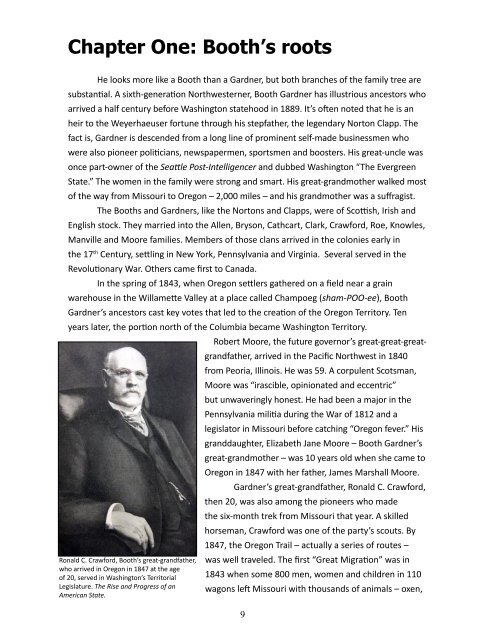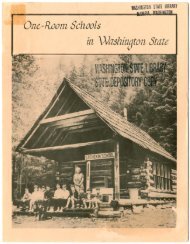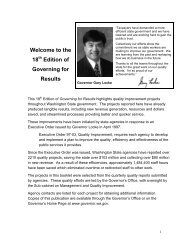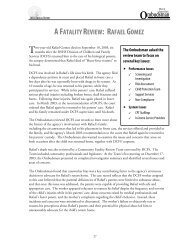BOOTH WHO? - Washington State Digital Archives
BOOTH WHO? - Washington State Digital Archives
BOOTH WHO? - Washington State Digital Archives
Create successful ePaper yourself
Turn your PDF publications into a flip-book with our unique Google optimized e-Paper software.
Chapter One: Booth’s roots<br />
He looks more like a Booth than a Gardner, but both branches of the family tree are<br />
substantial. A sixth-generation Northwesterner, Booth Gardner has illustrious ancestors who<br />
arrived a half century before <strong>Washington</strong> statehood in 1889. It’s often noted that he is an<br />
heir to the Weyerhaeuser fortune through his stepfather, the legendary Norton Clapp. The<br />
fact is, Gardner is descended from a long line of prominent self-made businessmen who<br />
were also pioneer politicians, newspapermen, sportsmen and boosters. His great-uncle was<br />
once part-owner of the Seattle Post-Intelligencer and dubbed <strong>Washington</strong> “The Evergreen<br />
<strong>State</strong>.” The women in the family were strong and smart. His great-grandmother walked most<br />
of the way from Missouri to Oregon – 2,000 miles – and his grandmother was a suffragist.<br />
The Booths and Gardners, like the Nortons and Clapps, were of Scottish, Irish and<br />
English stock. They married into the Allen, Bryson, Cathcart, Clark, Crawford, Roe, Knowles,<br />
Manville and Moore families. Members of those clans arrived in the colonies early in<br />
the 17 th Century, settling in New York, Pennsylvania and Virginia. Several served in the<br />
Revolutionary War. Others came first to Canada.<br />
In the spring of 1843, when Oregon settlers gathered on a field near a grain<br />
warehouse in the Willamette Valley at a place called Champoeg (sham-POO-ee), Booth<br />
Gardner’s ancestors cast key votes that led to the creation of the Oregon Territory. Ten<br />
years later, the portion north of the Columbia became <strong>Washington</strong> Territory.<br />
Robert Moore, the future governor’s great-great-greatgrandfather,<br />
arrived in the Pacific Northwest in 1840<br />
from Peoria, Illinois. He was 59. A corpulent Scotsman,<br />
Moore was “irascible, opinionated and eccentric”<br />
but unwaveringly honest. He had been a major in the<br />
Pennsylvania militia during the War of 1812 and a<br />
legislator in Missouri before catching “Oregon fever.” His<br />
granddaughter, Elizabeth Jane Moore – Booth Gardner’s<br />
great-grandmother – was 10 years old when she came to<br />
Oregon in 1847 with her father, James Marshall Moore.<br />
Gardner’s great-grandfather, Ronald C. Crawford,<br />
then 20, was also among the pioneers who made<br />
the six-month trek from Missouri that year. A skilled<br />
horseman, Crawford was one of the party’s scouts. By<br />
1847, the Oregon Trail – actually a series of routes –<br />
was well traveled. The first “Great Migration” was in<br />
1843 when some 800 men, women and children in 110<br />
wagons left Missouri with thousands of animals – oxen,<br />
Ronald C. Crawford, Booth’s great-grandfather,<br />
who arrived in Oregon in 1847 at the age<br />
of 20, served in <strong>Washington</strong>’s Territorial<br />
Legislature. The Rise and Progress of an<br />
American <strong>State</strong>.<br />
9
















